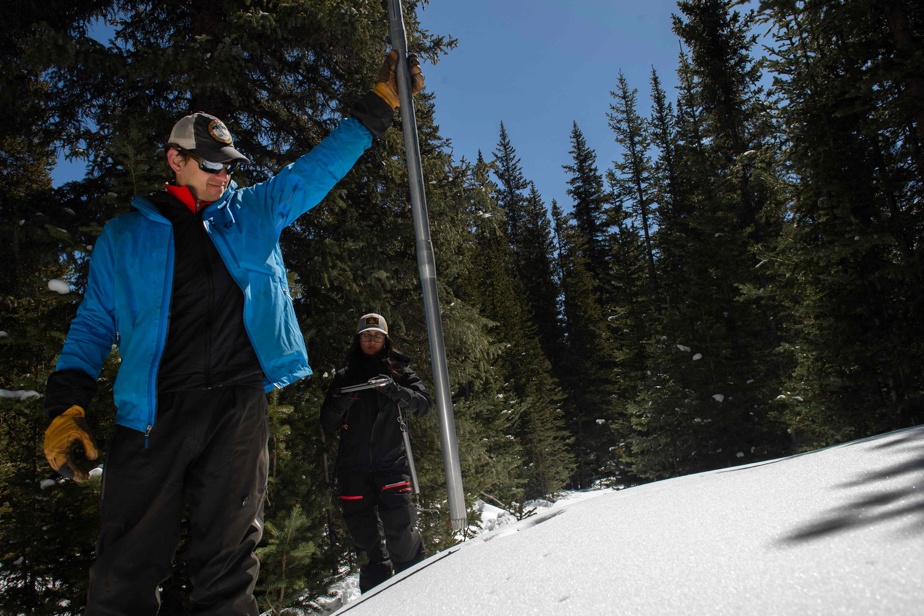In the middle of a pristine valley in the Rocky Mountains, two scientists armed with skis and notebooks watch the long hollow tube they have just driven into the thick snowpack covering the heights of Colorado, in the American West. .
“Twenty-four inches (61 centimeters, editor’s note) isn’t so bad”, rejoices Brian Domonkos, recovering the metal cylinder now filled with snow, which he then weighs with his colleague to measure its density.
Artisanal, the technique remains unchanged since 1966 on this crossing point located in Mosquito Creek, 160 kilometers from Denver. Each winter, it assesses the amount of water contained in Colorado’s snowpack, crucial data for the entire western United States.
Because once melted and released in the Colorado River, it is this dormant powder snow at an altitude of 3,000 meters that will make it possible to water cities such as Los Angeles in California and Phoenix in Arizona during the summer, located thousands of kilometers of this isolated valley.
“50 to 80% of the water we use in the West (of the United States) comes from the melting snow of the mountains”, explains to AFP Mr. Domonkos, bundled up in his blue ski jacket. The vast region constitutes “one and the same system. »
This year, the scientist’s measurements are particularly awaited. After more than 20 years of drought, aggravated by global warming, the large reservoirs in the region have reached historically low levels.
But a particularly rainy winter hit the western United States, including neighboring California. While much of the record rainfall has already flowed into the Pacific, the accumulated snow on the peaks could offer a brief respite and is being scrutinized as never before.
“ April’s snowfall measurement is really the highest point, the peak of the snowpack for most of Colorado”, continues Mr. Domonkos, who does not hesitate to quench his thirst by gulping down large handfuls of snow. . “This snowfall peak corresponds to the amount of water that will flow. »
Like him, employees of the “Colorado Snow Survey” carry out measurements at dozens of similar sites in the Rockies. A “ dream job ”, according to Mr. Domonkos, which allows them to rub shoulders with the majestic moose and elk in the unspoiled immensity of the peaks.
They also check, and repair if necessary, the automated measuring stations scattered throughout the mountain range. The combined data allows scientists to assess the importance of Colorado’s snowpack.
Useful information for ski resorts and hydroelectric power producers, but also for the state itself, which must provide a certain percentage of its water each year to its neighbors located downstream of the Colorado River.
“ It’s a huge responsibility”, breathes Nagam Gill, the team’s second scientist. If the calculations turn out to be wrong and the reservoirs let too much water into the river, “ we will never recover it ”, she explains.
During AFP’s visit to Mosquito Creek, the duo measured a snowpack comparable to that of recent years. But in the Colorado Basin, which starts just on the other side of the mountain and stretches all the way to California, the snow is “a little better,” Domonkos points out.
After the abundant falls this winter, the American Agency for Oceanic and Atmospheric Observation (NOAA) is indeed forecasting “ truly enormous figures ” concerning snowmelt, explains hydrologist Paul Miller. All of this water “is expected to flow into reservoirs in the upper Colorado River basin” this summer.
This federal agency “still relies heavily” on manual readings of the snowpack. It also incorporates data from satellite images and photographs taken in aircraft into its calculations.
According to Mr. Miller, everything indicates that the American West will have “a very wet year”. Lake Powell, a major reservoir in the region bordering Utah and Arizona, could thus receive a quantity of water twice as large as the annual average.
Good news, because like Lake Mead, another major reservoir near Las Vegas, its water level barely reaches a quarter of its capacity. With the next snowmelt, the two infrastructures should “reach the 30-35% range”, hopes Mr. Miller.
But amidst the snowy peaks of Colorado, Mr. Domonkos prefers to remain cautious.
“Even though we have much higher than normal snowpack in the Colorado Basin, that doesn’t mean at this point we’ll have a lot of runoff,” he explains. And whatever happens, the drought has been going on for so long that “ it will take several years to overcome it. »

